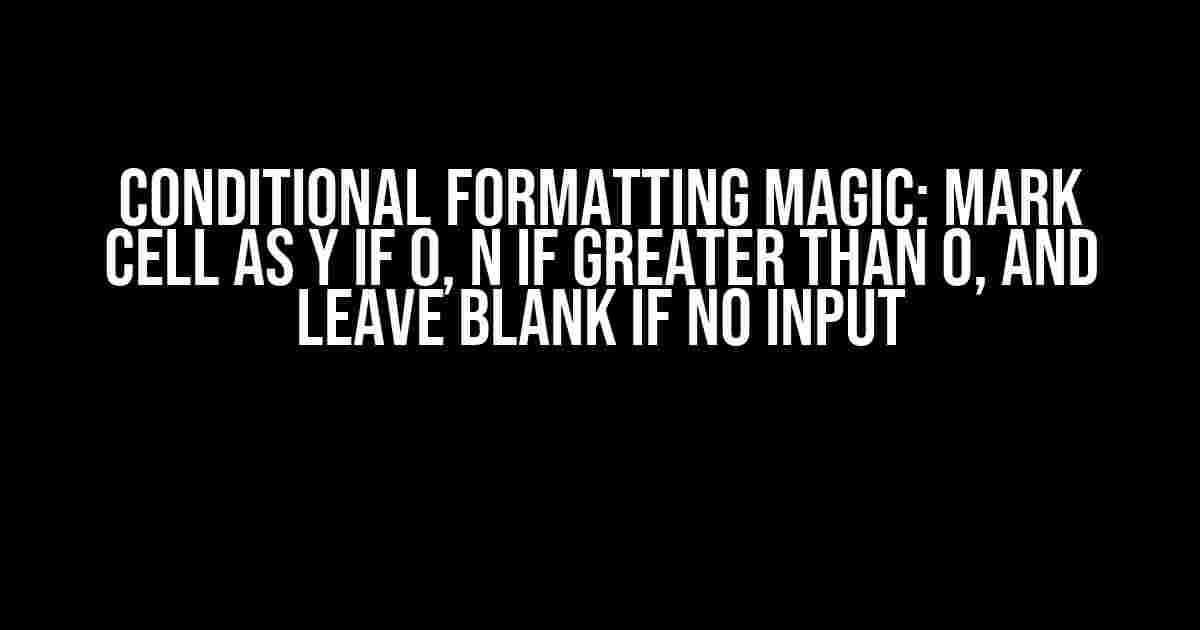Welcome to the world of conditional formatting, where a few clever tricks can transform your spreadsheets from dull to dazzling! Today, we’re going to tackle a specific problem that might just become your new favorite time-saver: marking a cell as “Y” if the value is 0, “N” if it’s greater than 0, and leaving it blank if there’s no input. Sounds like a mouthful, but trust us, it’s easier than you think!
The Problem: Inconsistent Data and Manual Entry
We’ve all been there – staring at a sea of numbers, trying to make sense of a messy spreadsheet. You’ve got columns upon columns of data, but the real challenge lies in making that data meaningful. That’s where conditional formatting comes in. Imagine being able to automatically flag cells that meet specific criteria, saving you hours of manual entry and reducing the likelihood of errors.
The Solution: IF Statements and Conditional Formatting
The key to this magic lies in using IF statements in combination with conditional formatting. Don’t worry if you’re not a whiz with formulas – we’ll break it down step by step.
=IF(A1=0,"Y",IF(A1>0,"N",""))
This might look like gibberish, but fear not! Let’s dissect the formula:
A1=0: This checks if the value in cell A1 is equal to 0."Y": If the value is 0, the formula returns the string “Y”.IF(A1>0,"N",""): If the value is not 0, this secondary IF statement kicks in.A1>0: This checks if the value in cell A1 is greater than 0."N": If the value is greater than 0, the formula returns the string “N”."": If the value is neither 0 nor greater than 0 (i.e., it’s blank), the formula returns an empty string, effectively leaving the cell blank.
Applying the Formula and Conditional Formatting
Now that we have our formula, let’s put it into action!
- Select the cell where you want to display the “Y”, “N”, or blank value.
- Go to the formula bar and enter the formula:
=IF(A1=0,"Y",IF(A1>0,"N","")) - Press Enter to apply the formula.
- Select the entire range of cells you want to format.
- Go to the “Home” tab in the ribbon and click on the “Conditional Formatting” button in the “Styles” group.
- Select “New Rule” and then “Use a formula to determine which cells to format”.
- In the formula bar, enter the same formula:
=IF(A1=0,"Y",IF(A1>0,"N","")) - Click on the “Format” button and select the desired format (e.g., a fill color or font style).
- Click “OK” to apply the rule.
| Value in Cell A1 | Result |
|---|---|
| 0 | Y |
| 1 | N |
| Blank | Blank |
Troubleshooting and Variations
As with any formula, there might be cases where things don’t go according to plan. Here are some common issues and their solutions:
- Error: #NAME? Make sure you’ve entered the formula correctly, and that the cell reference (A1) is accurate.
- Formula not working with blank cells Ensure that the formula is applied to the entire range of cells, including blank ones.
- Desired format not applying Check that the formatting rule is applied correctly and that the format is not being overridden by another rule.
If you want to get fancy, you can modify the formula to suit your specific needs:
=IF(A1>=10,"Y",IF(A1<=5,"N",""))
This formula marks cells as “Y” if the value is 10 or above, “N” if the value is 5 or below, and leaves them blank for anything in between.
Conclusion
Voilà! With this conditional formatting magic, you’ve successfully marked cells as “Y” if the value is 0, “N” if it’s greater than 0, and left them blank if there’s no input. This is just the tip of the iceberg – the possibilities are endless with IF statements and conditional formatting.
By applying this formula and formatting rule, you’ve not only saved time but also reduced the likelihood of errors. Your spreadsheets will thank you, and so will your sanity.
What’s your next conditional formatting challenge? Share your experiences and questions in the comments below!
Happy formatting!
Frequently Asked Question
Get the lowdown on marking cells with “Y” or “N” based on their values!
What happens if a cell has a value of 0?
When a cell has a value of 0, it gets marked with a “Y”! Simple as that.
What if a cell has a value greater than 0?
Easy peasy! If a cell has a value greater than 0, it gets marked with an “N”.
What about blank cells? How are they treated?
Blank cells are just that – blank! They won’t be marked with either “Y” or “N”, and will remain, well, blank!
Is this rule only applicable to numerical values?
Yes, this rule only applies to numerical values. If a cell contains text or other non-numeric data, it won’t be marked with “Y” or “N”.
Can I customize this rule to fit my specific needs?
Absolutely! While this rule provides a general guideline, you can always modify it to suit your specific requirements. Just get creative and adjust the conditions to fit your needs!

